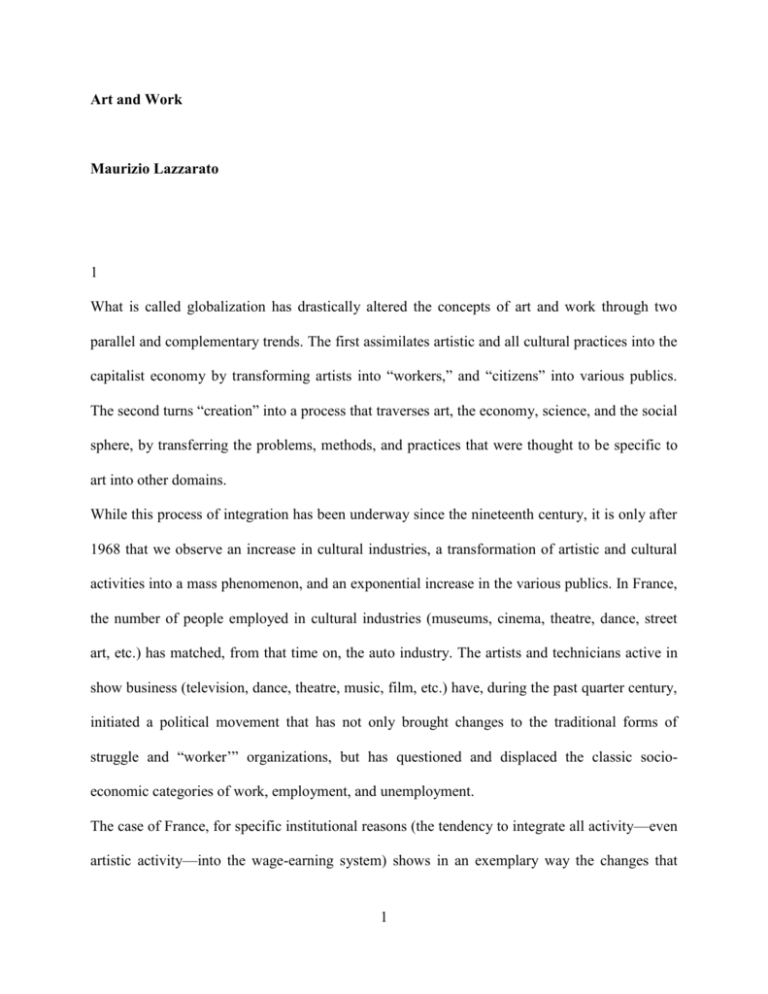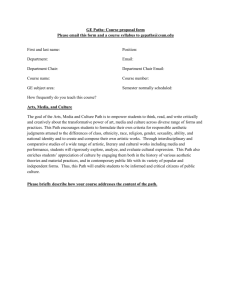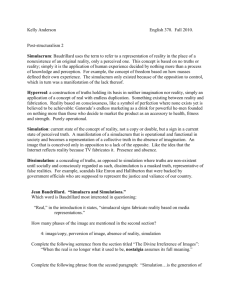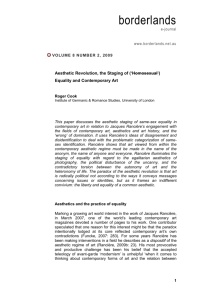Art & work - WordPress.com
advertisement

Art and Work Maurizio Lazzarato 1 What is called globalization has drastically altered the concepts of art and work through two parallel and complementary trends. The first assimilates artistic and all cultural practices into the capitalist economy by transforming artists into “workers,” and “citizens” into various publics. The second turns “creation” into a process that traverses art, the economy, science, and the social sphere, by transferring the problems, methods, and practices that were thought to be specific to art into other domains. While this process of integration has been underway since the nineteenth century, it is only after 1968 that we observe an increase in cultural industries, a transformation of artistic and cultural activities into a mass phenomenon, and an exponential increase in the various publics. In France, the number of people employed in cultural industries (museums, cinema, theatre, dance, street art, etc.) has matched, from that time on, the auto industry. The artists and technicians active in show business (television, dance, theatre, music, film, etc.) have, during the past quarter century, initiated a political movement that has not only brought changes to the traditional forms of struggle and “worker’” organizations, but has questioned and displaced the classic socioeconomic categories of work, employment, and unemployment. The case of France, for specific institutional reasons (the tendency to integrate all activity—even artistic activity—into the wage-earning system) shows in an exemplary way the changes that 1 profoundly affect the relations between art and work. Such changes that have led, in my opinion, to the crisis that Jacques Rancière has called “the aesthetic regime of art.” In this paradigm, art is a specific activity that suspends the usual spatio-temporal connections and coordinates of sensory experience—an experience characterized by the dualisms of activity and passivity, form and material, feeling and understanding. These dualisms (defined by Rancière as the “distribution of the sensible”) are political in the sense that they divide and hierarchize society through relations of domination. Such relations organize the power of people who stem from the realm of “refined culture” (activity) over those who are from the sphere of “simple nature” (passivity); it consolidates the power of leisured people (freedom) over working people (necessity), as well as the power of the intellectual working class (autonomy) over the manual working class (subordination). This idea of art, which is derived from Romanticism, promises to abolish the separation between “pleasure” and “work,” activity and passivity, autonomy and subordination, by means of two different methods: the first (engaged art, or art-become-life) acts politically by dissolving the separation between art and life, and thereby suppressing itself as an independent activity. The second (art for art’s sake, sovereign art) acts politically by jealously defending this very separation as a guarantee of independence from the world of commodities, markets, and the capitalist economy. It appears that this distribution of the sensible, which allocates places and functions in society, in the economy, in politics, as well as in art, has significantly changed. What does the separation between work and art signify when “artists” organize themselves collectively to defend their practices of work, employment, and unemployment? What does the separation between articulated speech (people of culture) and the inarticulate cry (people of 2 simple nature) signify when the political movement of irregular workers is made up of people for whom “work” means the command of language and the various pre-verbal and symbolic semiotics? What does the separation between autonomy and subordination, activity and passivity, intellectual work and manual work mean, when in the practices of artists and technicians of show business, these aspects meld and coexist? 2 It is difficult to find an answer to these questions in Rancière’s texts, in which the aesthetic paradigm of art remains current. So we will seek the reasons for this change in the “distribution of the sensible,” and its effects, in the works of Michel de Certeau and Félix Guattari. De Certeau’s hypotheses, formulated immediately after 1968, and those of Guattari, which were developed during the “winter years” (the 1980s), appear to perpetuate and echo the tradition of contemporary art, but in works that touch on the entire range of human practices. According to Michel de Certeau, from the beginning of the 1970s we can refer to a “new social partitioning” that is based more on relations between power and “culture” than on the “traditional divisions between workers and bourgeois, manual and intellectual workers”: The turf on which new bonds are produced between the economic sphere (the situation of consumers) and the political sphere (the distribution of power) is defined in cultural terms. 1 The classic divisions in Rancière’s distribution of the sensible, between workers and the bourgeoisie, intellectual work and manual work, do not disappear; rather, “mass culture” transforms the modes of existence, and, above all, the conditions of expression and subjectification of these divisions. 3 For example, the drive to consolidate a “worker culture” no longer corresponds to the will expressed by “the workers themselves, who are anxious to participate in the common culture, and hardly disposed to being closed off in a world of their own.”2 At issue is a new social partitioning, as violent as the former distribution of the sensible, even though it first occurs in the medium of signs, and is expressed through them. Culture is the domain of a neocolonialism, “it is the colonized world of the twentieth century,” says De Certeau, since it is here that the multinationals install their empires, in the same way that the European nations launched military occupations of unarmed continents in the nineteenth century: The corporate trusts rationalize and turn the manufacture of signifiers into a profitable enterprise. They fill the immense, disarmed, and almost somnolent space of culture with their commodities. All the forms of need, all the rifts of desire are “covered,” that is, inventoried, dealt with, and exploited by the media. This economic system erodes and ultimately inverts the political experience acquired in the nineteenth century, replacing the act of democratic representation with the reception of standardized signifiers that destine workers to become consumers, and that turn people into a public mass.3 The artists, the technicians, and the cultural operators “work,” like the various publics, in the nerve centre of this new domain of capitalist accumulation and acculturation. 3 Art and culture are bound up with and participate in the configuring of a new situation in which the problems are no longer those of disciplinary societies; art and culture crystallize around this “common culture” which constitutes the horizon and shared footing of our socialization and individuation. People have always been implicated in a signifying semiotic system. But in the new social partitioning the “various systems of signs” play a strategic role in both economic production and 4 the control and organization of social divisions. This led Guattari to define capital as a semiotic “operator.” Corporeal semiotics, the non-verbal semiotics (of childhood, of the mad, of youth, of women, of sexual or linguistic minorities) are no longer disciplined and/or repressed as in disciplinary societies. On the contrary, the heterogeneity of percepts and affects—of desires—are invested, mobilized, and solicited by and through consumption and communication, resulting in the homogenization of a subjectivity that conforms to market demands. According to Guattari, “capitalism takes hold of human beings from the inside” by grafting itself onto, among other things, perceptual, sensorial, affective, linguistic, and cognitive behaviour. It reworks the modes of semiotic practice on both the individual and collective level. “Individuals are ‘equipped’ with modes of perception or of standardized desire, for the same reason as the factories, the schools, and territories.”4 Affects, percepts, and statements become the matter and reality of marketing’s expression—of advertising, of television images, and of the market in general. Speech, signs, and discourse circulate and proliferate “freely,” but they are drained of all their power to transform. They even inhibit the appearance of conditions of singular expression because, as De Certeau puts it, “their drone creates an absence of speech.” Gilles Deleuze had warned us: “Do you know what it takes to stop someone from speaking in his/her own name? Make them say, ‘I’.”5 All semiotics are summoned to rebuild the representation of the subject, to affirm the “I” of a new individualism. Television programs give the subject speech; polls challenge people daily, but subjectivity has lost its singularity and any possibility of finding its own expression. On the contrary, it is at the mercy of a growing uniformity, and a reductionism that begins by affecting 5 the sensibility. The flow of signs is not subjected to any censorship in the classical sense, and yet it withdraws and neutralizes the conditions of articulation, expression, and subjectivity in a way that is even more effective than repression. There are machines with words, emotions, and images that prevent talking, feeling, and seeing. 4 How is one to resist these new semiotic machines of capitalist accumulation? How is one to arm oneself against this new distribution of the sensible in which there is no longer a rupture between art and work, but rather a continuity? How is one to avoid letting the needed creativity of a society be reduced to the level of “leisures?” Félix Guattari encourages us to consider and discuss the hypothesis of the emergence of a new aesthetic paradigm. This is not an aesthetic paradigm of art like Rancière’s, but a new aesthetic paradigm pure and simple, one not limited to a proposition aimed at aestheticizing the social sphere. The promotion of this new paradigm is “called to overturn the present forms of art as much as those of social life.”6 Guattari is referring to art as a paradigm that underscores a number of problems, problems that have several points in common with the “program” of Duchamp and Beuys. The aesthetic paradigm, in Beuys’s approach, is not to say that every person is an artist, but to claim that there is some creation in all activity. It would be better, then, to speak, before it solidifies into works and products, of a proto-aesthetic paradigm, to emphasize the fact that we are not referring to institutionalized art, to works expressed in the social arena, but to a dimension of creativity in its nascent state, flowing from the source, with the power of the emergent.”7 6 Art has thoroughly examined the modes of social formation, the movement and social crystallization of affects, percepts, and articulations. The relation of the spectator to the image, to music, to speech and writing, which today constitute the forms of submission and subjection to the market and cultural industries, has been the subject of artistic practices for a long time. They have revealed subjectification as a process in which many semiotic components (verbal, preverbal, non-signifying, symbolic), both heterogeneous and fragmentary, are crystallized. In a word, art should not produce ready-made works or aesthetic objects, but rather conceptual, aesthetic, and social instruments through which are re-appropriated the videographic, computational and linguistic orders of expression, “of which the various publics would make use at their convenience.”8 The aesthetic paradigm would no longer be simply a matter of artistic creation and artistic subjectivity, but would delineate a possible direction for creativity. Such an approach must be focused more on the process than on the object, on the emerging creation rather than on the “work.” “Creation comes from origins further removed than its authors, ostensible subjects, and exceeds their works, objects whose closure is fictive.”9 It must shield expression from the serial force of captive words—words reworked and spit out by the media—by promoting the multiplicity of things to be expressed, and thus the polyphony of arrangements of articulation. “Will it be possible for humans to create spaces for themselves in which their own speech can be proffered?”10 asks De Certeau. It must contribute to the creation of centres of subjectification. The act of creation, no longer essentially concerned with creating a work or a finished product, would mediate a collective operation, allowing both a group and a singularity to exist. An event is made in making a language. 7 The “existential function” of Guattari’s act of creation, as the affirmation of a territory, is to be able, with the support of certain discursive or semiotic links, to “deflect [those links] from their fate as denotative or propositional signifiers, so that they will play a role of existential affirmation.”11 The act or existential function leads to the creation of a territory, a group, a singularity, a meaning. But it is only possible to articulate the meaning of a situation in relation to an action undertaken to transform it. To situate oneself somewhere, to create a territory or new modes of subjectification and articulation, is both a political and an existential question. And this concerns social practices as much as artistic practices. There can be no “cultural politics” unless sociocultural situations can be fashioned in terms of present forces and commonly known oppositions. It remains to be seen whether the members of a society—today drowned in the anonymity of discourses of which they are dispossessed, and subject to conglomerates whose control exceeds their grasp—will find, along with the power of locating themselves in a game of acknowledged forces, the means of capturing speech.12 We cannot avoid the political problem, even if the modes of political action are no longer those codified and integrated into the institutions of the former distribution of the sensible. In the new conditions, the first goal of political action is not to satisfy the “needs,” but “to build, through controlled interventions, laboratories of social experimentation.”13 The transformations of art and work open up new possibilities, but also new responsibilities for social and artistic practice, the full scope and implications of which have not yet been assessed. 8 Maurizio Lazzarato is an independent sociologist. He conducts research on the non-physical aspects of work—the destabilizing of the wage earner, the ontology of work, and cognitive capitalism. He published Puissance de l’invention. La psychologie économique de Gabriel Tarde contre l’économie politique (2002) and Les révolutions du capitalisme (2004) with the publisher Les Empêcheurs de penser en rond. He is a member of the editorial board of the journal Multitudes. Translated by Mark Heffernan Notes 1. Michel de Certeau, Culture in the Plural, trans. Tom Conley (Minneapolis, Minnesota: University of Minnesota Press, 1997), ——————. 2. Ibid., ——————. 3. Ibid., ——————. 4. Félix Guattari, Molecular Revolution: Psychiatry and Politics, trans. Rosemary Sheed (Harmondsworth: Penguin, 1984), ——————. 5. Gilles Deleuze, Deux régimes de fous (Paris, Minuit, 2003), 75. Our translation. 6. Félix Guattari, Chaosmosis: An Ethico-Aesthetic Paradigm, trans. Paul Baines and Julian Pefanis (Bloomington, Indiana: Indiana University Press, 1995), ——————. 7. Ibid., ——————. 8. Ibid., ——————. 9 9. De Certeau, op. cit., ——————. 10. Ibid., ——————. 11. Guattari, Chaosmosis, ——————. 12. De Certeau, op. cit., ——————. 13. Ibid., ——————. Translation modified. 10








